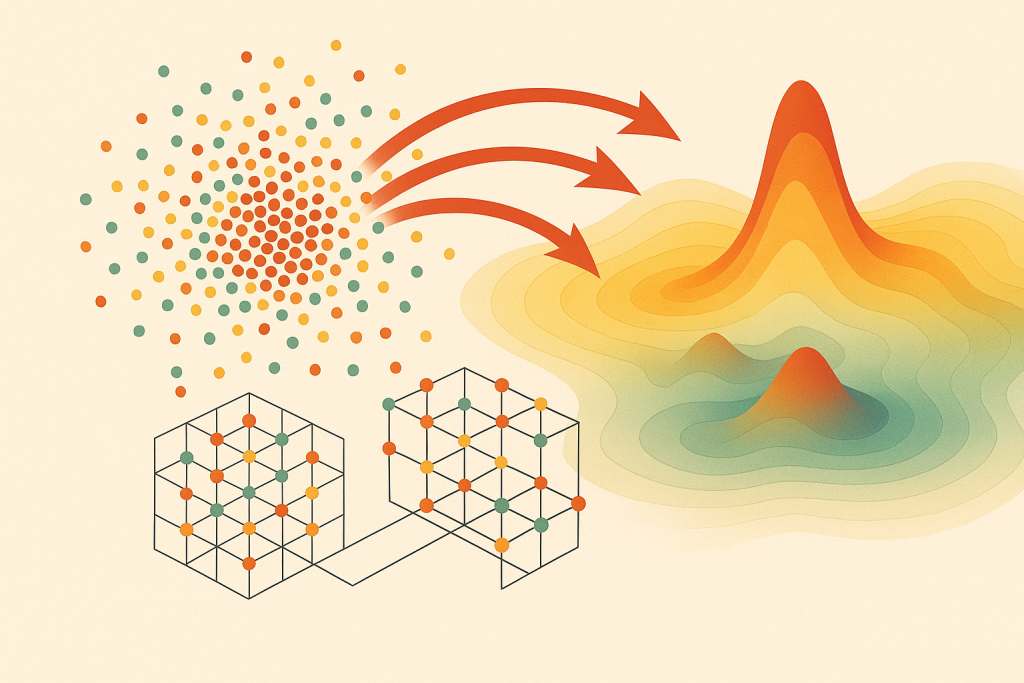
Imagine copying a friend’s workout plan by hand and sharing it in your group chat. A few people fix a line, others tweak an exercise, and someone adds a rest day. Soon, there isn’t one “original” plan. There’s a cloud of similar versions, with one popular template in the center and numerous nearby variations. That living swarm of copies is how Manfred Eigen, John McCaskill, and Peter Schuster describe molecules that copy themselves with small errors. They call it a quasi-species: not a single perfect sequence, but a whole population clustered around a “master” one. Selection acts on the cluster, not just the one pristine original.
According to Eigen and colleagues, you can picture all possible sequences laid out in a vast “sequence space,” where distance means how many positions differ (the Hamming distance). Close neighbors are only one typo away; far ones need many changes. In high dimensions, there are countless short routes between any two points, so many ways to wander by small mistakes. That matters because copying is never perfect. A master sequence tends to be the best copier, but its mutants also copy, and together they form a stable crowd that wins because, as a group, they reproduce more effectively than rivals. Think of clans rather than isolated individuals—whoever owns the strongest “mode” of the population dominates.
There’s a catch called the error threshold. If copies are too sloppy, the crowd can’t stay clustered, and the “message” dissolves. In plain terms: the longer the sequence, the higher the bar for accuracy; if fidelity drops, the system can’t hold specific information. The authors demonstrate that selection can be viewed as hill-climbing on a landscape, where the population tends to converge toward better replicators, provided that errors are low enough to maintain group cohesion. Even cooler, evolution isn’t purely a random stumbling process. Because more successful variants become more common, new mutants tend to appear at the populated edges along “ridges” that connect good regions—so change is biased toward success. It’s like a playlist algorithm nudging you from one favorite song to another via similar tracks.
Why should you care? Because this is how ideas, habits, and even internet memes behave. Your study method, your budget, your fitness routine—each lives as a quasi-species of versions you try, keep, and share. Keep errors small in the parts that carry meaning (your essential steps), or the routine turns to noise. Allow some variation to occur at the edges so you can discover better peaks without losing the overall plot. And when you want real progress, look for ridges: minor, low-risk tweaks that connect what already works to something better. You don’t need a perfect plan; you need a stable core with room to explore. That is the everyday power of quasi-species thinking that Eigen, McCaskill, and Schuster brought to light.
Reference:
Eigen, M., McCaskill, J., & Schuster, P. (1988). Molecular quasi-species. The Journal of Physical Chemistry, 92(24), 6881–6891. https://doi.org/10.1021/j100335a010
Privacy Notice & Disclaimer:
This blog provides simplified educational science content, created with the assistance of both humans and AI. It may omit technical details, is provided “as is,” and does not collect personal data beyond basic anonymous analytics. For full details, please see our Privacy Notice and Disclaimer. Read About This Blog & Attribution Note for AI-Generated Content to know more about this blog project.